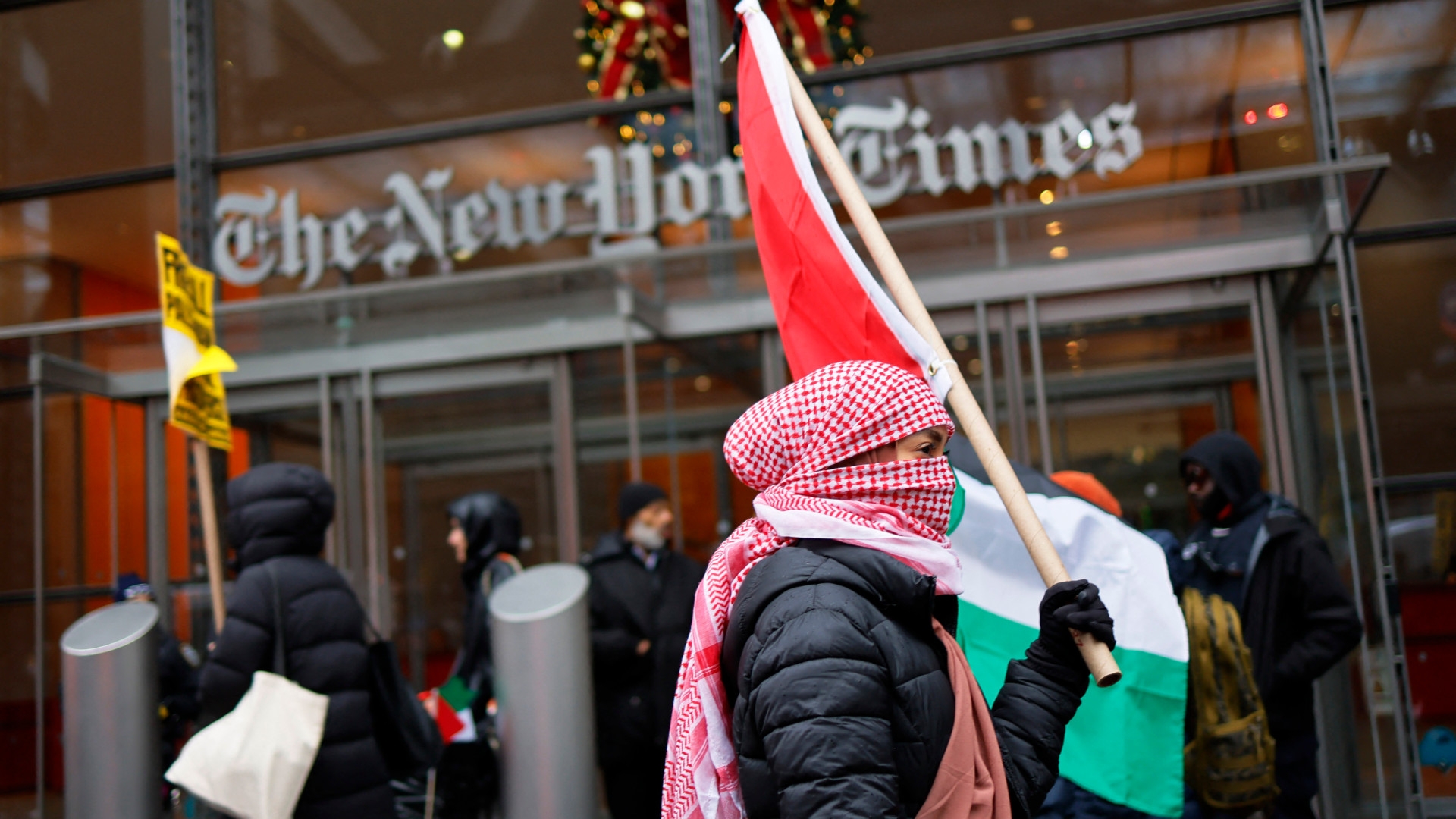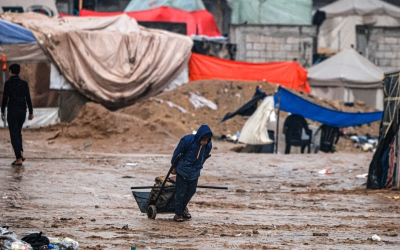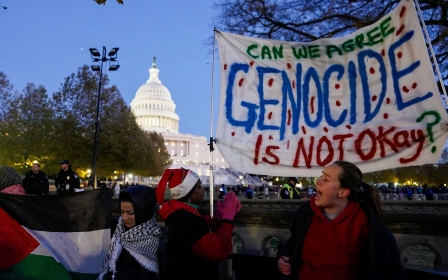War on Gaza: How US mainstream media incites hate of Arabs and Muslims

The last week has provided an object lesson in how propaganda functions.
Three forms of misleading, pro-war coverage of the unfolding US-Israeli wars across the Middle East stand out. These concern US news outlets such as CNN, which says it reaches 80 million American households, and two of the country’s most widely circulated newspapers, The New York Times and The Wall Street Journal.
Palestine is the fulcrum of the US-Israeli wars in Yemen, Syria, Iraq, and Lebanon. A Guardian report this week from Chris McGreal reveals that CNN has systematically distorted its coverage of Palestine-Israel since 7 October when the war in Gaza broke out.
The article is based on accounts from six CNN staffers in several newsrooms and over a dozen internal memos and emails that The Guardian obtained. The picture emerging from the piece is of the outlet’s top brass seeking to exert maximum control over reporters to shape coverage so that it aligns with network leadership’s political preferences.
For example, McGreal reports that CNN limits the space given to Palestinian points of view while routinely allowing Israeli officials’ claims to be aired unchallenged.
New MEE newsletter: Jerusalem Dispatch
Sign up to get the latest insights and analysis on Israel-Palestine, alongside Turkey Unpacked and other MEE newsletters
That tendency led, for instance, the network to present the false story that Hamas beheaded 40 Israeli babies and toddlers as though it were true. The story remained live even after the Biden administration acknowledged that the president had not, as he previously claimed, seen non-existent proof of the decapitations.
Moreover, CNN’s Palestine coverage has to be approved by its Jerusalem bureau, which CNN staffers say skews reporting in Israel’s favour.
That Israel has long colonised and oppressed Palestinians is relevant information that CNN has omitted from the vast majority of its reports
People working at CNN note that, especially in the early phases of the Israeli onslaught, CNN’s policies resulted in “a greater focus on Israeli suffering and the Israeli narrative of the war as a hunt for Hamas and its tunnels, and an insufficient focus on the scale of Palestinian civilian deaths and destruction in Gaza.”
Likewise, my analysis of CNN’s coverage of Israel’s war on Gaza reveals a dearth of stories that contextualise the events of 7 October or focus on Palestinian suffering, both historic and ongoing. This has continued despite the massive civilian casualties suffered on the Palestinian side and the humanitarian catastrophe taking place in Gaza.
That Israel has long colonised and oppressed Palestinians and is waging a war of annihilation against all aspects of Palestinian life is relevant information that CNN has omitted from the vast majority of its reports.
Given the widespread failure of American news outlets to cover Palestine accurately, one suspects that a process similar to the one prevailing at CNN is operating at other news organisations.
Dehumanising the adversary
“Understanding the Middle East Through the Animal Kingdom” is the latest dispatch from New York Times columnist Thomas Friedman. The piece rests on the Orientalist conceit that the region is a “jungle” populated by beasts rather than people.
Follow Middle East Eye's live coverage of the Israel-Palestine war
“The US is like an old lion”, the author declares. “We are still the king of the Middle East.” Quite the complement for the Americans: lions are noble, brave, beautiful creatures. In contrast, according to Friedman, Iranians and their allies are parasitic bugs:
“Iran is to geopolitics what a recently discovered species of parasitoid wasp is to nature. What does this parasitoid wasp do? According to Science Daily, the wasp ‘injects its eggs into live caterpillars, and the baby wasp larvae slowly eat the caterpillar from the inside out, bursting out once they have eaten their fill.’
Is there a better description of Lebanon, Yemen, Syria and Iraq today? They are the caterpillars. The Islamic Revolutionary Guard Corps is the wasp. The Houthis, Hezbollah, Hamas and Kataib Hezbollah are the eggs that hatch inside the host - Lebanon, Yemen, Syria and Iraq - and eat it from the inside out.
We have no counterstrategy that safely and efficiently kills the wasp without setting fire to the whole jungle. Hamas is like the trap-door spider.”
This is exterminationist rhetoric - who, after all, does one call upon discovering a bug infestation? That the Times would publish an article that expressly longs for Iran to be “safely and efficiently kill[ed]” lays bare the paper’s ethical bankruptcy. Netanyahu, for his part, gets compared to a lemur - whether that’s a flattering analogy is debatable, but it beats being called a parasitic insect.
Setting aside that there are, of course, “better description(s)” of Lebanon, Yemen, Syria and Iraq today than “caterpillars” (how stunning it is to have to write such a sentence!) - “rich, diverse societies” comes to mind - let’s pretend for a moment that Friedman deserves to be taken seriously (which he doesn’t).
To claim that these nations, or Palestine, are being “eat[en]” from the inside out by Iranian “larvae” is to deploy a racist metaphor that papers over the American lion’s leading role in unleashing devastation on the civilian populations of Palestine, Lebanon, Yemen, Syria, Iraq, and Iran in very recent history.
That groups like Ansar Allah (“the Houthis”), Hezbollah, and Hamas have large, organic, popular bases among the populations in which they exist is a further problem for Friedman’s entomology.
Inciting hate
Last week, Steven Stalinsky took to the pages of The Wall Street Journal to launch an Islamophobic rant against Dearborn, Michigan’s Muslim population. His evidence of this alleged menace includes, in his paragraph, images of “Protesters, many with kaffiyehs covering their faces, shout “Intifada, intifada”, “From the river to the sea, Palestine will be free”, and “America is a terrorist state”.
The author offers no rationale as to why readers should regard it as malevolent and frightening that Dearborn residents wear a symbol of solidarity with the Palestinian struggle against Israel, call for an end to settler colonialism between the Jordan and the Mediterranean, and denounce the US government’s extensive history of mass violence against civilians.
He unleashes the dual loyalty trope, invoking “Local enthusiasm for jihad against Israel and the West” and an area imam who Stalinsky says has “essentially declar[ed] allegiance to the Iranian ayatollah who regularly calls for the destruction of the US”.
Stalinsky informs his readers that “Many current or one-time Dearborn residents have been convicted of terror-related crimes in recent years.”
The snitch-piece concludes that “What’s happening in Dearborn isn’t simply a political problem for Democrats. It’s potentially a national security issue affecting all Americans. Counterterrorism agencies at all levels should pay close attention.” These remarks suggest that, for Stalinsky, American Muslims are dangerous and ought to be surveilled and harassed by US law enforcement, never mind its long record of targeting Muslims.
Framing Muslims as a fifth column helps create a climate for war. Fostering fear and hatred of a domestic minority nurtures fear, xenophobia, and deference to state authorities, all of which are useful to getting a critical mass of the population to go along with their government’s militarism.
What all of this bigoted, war-mongering propagandising illustrates is that it’s more necessary than ever to turn to and support independent media.
The views expressed in this article belong to the author and do not necessarily reflect the editorial policy of Middle East Eye.
Middle East Eye delivers independent and unrivalled coverage and analysis of the Middle East, North Africa and beyond. To learn more about republishing this content and the associated fees, please fill out this form. More about MEE can be found here.






